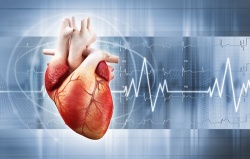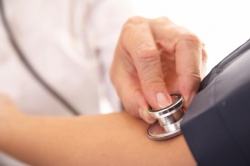Hypotension (Low Blood Pressure)
Blood pressure that is lower than normal for an individual is referred to as hypotension. Hypotension can be short-lasting, such as orthostatic hypotension or can be a chronic conditions. Hypotension may be brought on by specific dietary and exercise regimens, as a result of prescription medication, or it may be a symptom of another underlying condition. In some cases hypotension can indicate a life-threatening situation. Although hypotension is typically a concern when extremely low, chronic moderately low blood pressure is associated with decreased mortality.[1] Hypotension is also associated with decreased cognitive function, especially in the elderly.[2] [3]
|
Hypotension | |
| Causes | Dietary Factors, Breathing Disorders, Prescription Medications |
|---|---|
| See Also | Cardiovascular Conditions, Hypertension |
| Books | Books on Cardiovascular Conditions such as Blood Pressure: A Naturopathic Approach and others. |
| Articles | Articles on Cardiovascular Conditions |
Naturopathic Assessment
| Read this book | Naturopathic Treatment of Blood Pressure |
|---|
| Read this book | Blood Pressure: A Naturopathic Approach |
|---|
Causal Factors
Hypotension may be normal for an individual or it may be a symptom of an underlying condition. In order to stimulate the innate ability of the body to heal, the causes of disease must be identified and addressed. With hypotension, the causes are variable. It is important to identify and address any underlying that is causing the low blood pressure.
Lifestyle
- Long standing bed rest may contribute to hypotension.[6]
- Combining resistance and aerobic exercise can elicit hypotension, especially when the intensity of the aerobic exercise is higher than 65% VO2peak.[8]
- Post-exercise hypotension may occur, especially in the elderly and those with hypertension, after aerobic exercise. Resistance exercise does not appear to elicit post-exercise hypotension to the same degree.[9]
- Breathing disorders, especially upper airway resistance syndrome, is associated with lower blood pressure.[10]
- In some older persons with sleep-related breathing disorders, sympathetic reflexes may be impaired, permitting hypotension and risk of circulatory failure. Epidemiologic evidence supports the hypothesis that this mechanism can explain the elevated incidence of cerebral infarction during sleep.[11]
Social
- Psychological distress can cause hypertension in some individuals and hypotension in others.[7]
Medical Interventions
- Prescription Medications
- A number of prescription mediciations can cause or contribute to hypotension, as such it is important to review all medications.[7], [6]
- Antihypertensive, vasodilatory drugs or diuretic agents like furosemide, bumetanide and ethacrynic acid can induce hypovolemia and subsequent hypotension. Medications indicated in hypotension include:
- Vasodilators such as verapamil, nifedipine or diltiazem.
- Angiotensin converting enzyme inhibitors.
- Monoamine oxidase inhibitors.
- Tricyclic or tetracyclic antidepressants.
- Others; quinine, L-dopa, barbiturates and alcohol.
Physiology
- Coughing, a common bodily urge, can cause temporary hypotension.[7]
- Excessive sweating can cause hypotension if fluids are not replaced.[6]
Diagnostic Testing
- In Office Testing
- Measurement of blood pressure with a properly fitting cuff done in the office is the primary method of evaluating hypotension. A diagnosis of hypotension is made after three consecutive readings when the systolic blood pressure is less than 90 and the diastolic is less than 60.[6]
Related Symptoms and Conditions
The following conditions are associated with or may contribute to the onset of hypotension:[6][7][12]
- Anemia.
- Hemorrhage
- Dehydration
- Osmotic diuresis in uncontrolled diabetes without adequate fluid or electrolyte replacement.
- Severe varicose veins or excess venous pooling.
- Addison's Disease in the absence of adequate salt intake.
- Cardiogenic shock associated with Myocardial infarction.
- Decreased cognitive decline
- Dementia
- Diabetic complications, especially peripheral neuropathy
- Parkinson’s disease.
- Anorexia nervosa
- Convulsive syncope or seizure activity
- Hypothyroidism
Characteristics
Hypotension is often a response or a symptom of another underlying condition. A moderately low blood pressure that is healthy for an individual can be the outcome of a healthy diet and/or regular exercise regimen. It is also common for the elderly to have lower blood pressure.
- Orthostatic hypotension is defined as a decrease in blood pressure within 3 minutes of assuming an upright position, and is diagnosed in the presence of a systolic decrease in blood pressure of more than 20mmHg or a diastolic change greater than 10mmHg.[13]
Common Symptoms
Hypotension may be acute or chronic, as well as symptomatic or asymptomatic. Although often asymptomatic, the following signs and symptoms can be associated with hypotension:[4][12]
- Dizziness on standing up
- Decreased exercise tolerance
- Faintness
- Weakness
- Fatigue
- Light-headedness
- Visual disturbances, blurred vision or night blindness.
- Nasal stuffiness
- Headache
- Sycope or shock could occur with severe hypotension depending on the underlying cause.
- Head and neck discomfort
- Decreased cognitive ability
- Severe vomiting and diarrhea.
- Excessive sweating.
Naturopathic Treatment
The goal of naturopathic treatment is to support and work in tandem with the healing power of the body and to address the causal factors of disease with individual treatment strategies. Hypotension can be an acute condition or a chronic disease state. When deciding on the best treatment options it is important to have a clear understanding of the underlying causal factors and any associated conditions.
It is always advisable to work with a naturopathic doctor before engaging in any treatment plan.
Home Care
Home Care strategies include:
- As hypotension increases the risk of falling it is important to take steps to decrease this risk.
- Move from a lying position to a seated position before standing.[7]
Lifestyle
Lifestyle recommendations include:
- Smaller more frequent meals.
- Adequate salt intake. If currently on a vegetarian or low-fat diet it may be advantageous to increase meat protein and healthy fats and oils into your diet.
- Ensure you drink adequate water.[7]
- Exercise, especially resistance exercise, can be beneficial in the treatment of hypotension.
- Addressing any breathing disorders is recommended.
Naturopathic Therapies
The prescribing of naturopathic therapies requires the guidance of a naturopathic doctor as it depends on a number of factors including the causal factors, a person's age, prescription medications, other conditions and symptoms and overall health. It is always advisable to work with a naturopathic doctor prior to taking any natural therapies.
- Licorice (Glycyrrhiza glabra), Hawthorn (Crataegus oxyacantha), Lily of the Valley (Convallaria majalis), Gentiana (Gentiana lutea), Camphor (Cinnamomum camphora)
- Gemmotherapies such as Quercus robur
- 5 to 10 minute Russian baths done on a daily basis can be beneficial in the treatment of hypotension.[15]
References
Reviewed by Iva Lloyd, BScH, RPE, ND [3]
- ↑ Wessely S, Nickson J, Cox B(1990) Symptoms of low blood pressure: a population study. BMJ.;301(6748):362-5.PMID:2400856.
- ↑ Novak Vera, Hajjar Ihab (Dec 2010) The relationship between blood pressure and cognitive function Nat Rev Cardiol;7(12):686-698. [1]
- ↑ Qiu C, Winblad B, Fratiglioni L (Aug 2005) The age-dependent relation of blood pressure to cognitive function and dementia. Lancet Neurol;4(8):487-99. PMID: 16033691 [2]
- ↑ 4.0 4.1 4.2 Kroll M, Ring C, Gaus W, Hempel B (2005) Safety and Efficacy of a Crataegus Extract in Older Patients with Orthostatic Hypotension, A randomized trial of Korodin Herz-Kreislauf-Tropfen as add-on treatment in older patients with orthostatic hypotension. Phytomed;12:395-402.
- ↑ Beilin LJ, Rouse IL, Armstrong BK, Margetts BM, Vandongen R (1988) Vegetarian diet and blood pressure levels: incidental or causal association? Am J Clin Nutr.;48(3 Suppl):806-10. PMID:3046309.
- ↑ 6.0 6.1 6.2 6.3 6.4 6.5 Berga S, Bowman M, Drossman D, Faling J, Frenkel E, Gabbard G et al. editors.(1992) The Merck Manual of Diagnosis and Therapy 16th edition. Rathway: Merck & Co Inc.
- ↑ 7.0 7.1 7.2 7.3 7.4 7.5 7.6 Mulley A, editors.(2009) Primary Care Medicine – Office evaluation and management of the adult patient. Lippincott Williams and Wilkins.
- ↑ Keese F, Farinatti P, Pescatello L, Cunha FA, Monteiro WD (Feb 2012) Aerobic exercise intensity influences hypotension following concurrent exercise sessions. Int J Sports Med.;33(2):148-53.
- ↑ Gomes Anunciação P, Doederlein Polito M (May 2011) A review on post-exercise hypotension in hypertensive individuals. Arq Bras Cardiol.;96(5):e100-109.
- ↑ Guilleminault C, Faul JL, Stoohs R (Oct 2001) Sleep-disordered breathing and hypotension. Am J Respir Crit Care Med.;164(7):1242-7.
- ↑ McGinty D, Beahm E, Stern N, Littner M, Sowers J, Reige W (Aug 1988) Nocturnal hypotension in older men with sleep-related breathing disorders. Chest.;94(2):305-11.
- ↑ 12.0 12.1 Hollister AS (1992) Orthostatic hypotension. Causes, evaluation, and management. West J Med.;157(6):652-7. PMID:1475949.
- ↑ Lahrmann H, Cortelli P, Hilz M, et al (2006) EFNS guidelines on the diagnosis and management of orthostatic hypotension Eur J Neurol;13:930-6
- ↑ Schandry R, Duschek S (2008) Positive Association between Elevating Blood Pressure and Improved Cognitive Function after Supplementation with Hawthorn Berry Extract and Camphor. The effect of Camphor-Crataegus berry extract combination on blood pressure and mental functions in chronic hypotension—a randomized placebo controlled double blind design. Phytomed;15: 914-922.
- ↑ Boyle W, Saine A (1988) Lectures in Naturopathic Hydrotherapy. Eclectic Medical Publications.:p75


